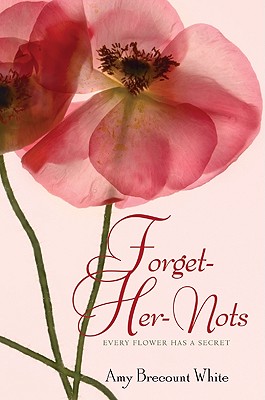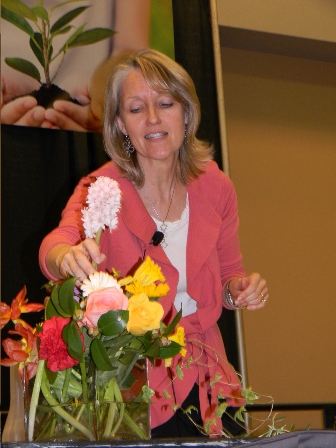 The scent of
rosemary fills the air at Amy Brecount White's appearances promoting her debut YA
novel, Forget-Her-Nots (Greenwillow
Books, $16.99). She presents attendees with sprigs of the
herb--which stands for remembrance--to provide a tactile experience while she
reads a passage from the story in which it's mentioned.
The scent of
rosemary fills the air at Amy Brecount White's appearances promoting her debut YA
novel, Forget-Her-Nots (Greenwillow
Books, $16.99). She presents attendees with sprigs of the
herb--which stands for remembrance--to provide a tactile experience while she
reads a passage from the story in which it's mentioned.
In Forget-Her-Nots, 14-year-old Laurel researches the language of flowers for a school project and discovers that the Victorian symbolic bouquets (or tussie-mussies) she creates have unintended and mysterious effects like making people fall in love or ace tests.
Since the book's publication last year, White, who lives in Arlington, Va., has found avid audiences for the magical realism tale among gardeners and flower enthusiasts. Earlier this month she appeared at the Philadelphia International Flower Show, where she gave a presentation on the language of flowers throughout Western history from its roots in Greek mythology to its uses in Shakespeare's works and beyond.
White has spoken at garden club meetings, as well at the Potomac Unit of the Herb Society of America and the U.S. Botanic Garden's Plant Literacy Festival. In addition, she has reached out to places such as the Matthaei Botanical Gardens in Ann Arbor, Mich., and Longwood Gardens in Kennett Square, Pa., both of which stock the book in their gift shops.
At each event, White demonstrates how to make tussie-mussies that convey meanings such as congratulations, romance or forgiveness. (If you need help with the latter, try white tulips.) She uses plants from her own garden or ones that can be purchased inexpensively. Lucky audience members leave with the bouquets, which are traditionally accompanied by a card explaining the significance of the blooms. Forget-Her-Nots includes a glossary of the most common flowers and herbs and what they represent.
 "I'm
helping people incorporate the language of flowers into their lives,"
White said. "We all know that when someone gives you flowers it brightens
your day, but you can do it more specifically by sending flowers and herbs with
a particular message."
"I'm
helping people incorporate the language of flowers into their lives,"
White said. "We all know that when someone gives you flowers it brightens
your day, but you can do it more specifically by sending flowers and herbs with
a particular message."
The first tussie-mussie White created was for an ailing friend. She was inspired to make the bouquet after coming across a coffee table book on the subject at Books & Company in her hometown of Dayton, Ohio. As she assembled it and wrote out the card, she found herself wishing that the get-well sentiment behind it would actually occur. "That got my wheels spinning," she said. "What if you gave someone flowers and herbs and it came true, that there was magic there." The idea blossomed into Forget-Her-Nots, which is set at an all-girl's high school reminiscent of one where White used to teach English.
The book has garnered a following among readers of varying ages, due in part to the historical perspective on flowers and the multi-generational storyline featuring Laurel's relationships with her grandmother and her late mother. White has spoken to audiences ranging from middle school kids to book club members in their 60s and 70s, amateur horticulturists and master gardeners to Arlington-area newcomers.
During her presentations, as in the pages of Forget-Her-Nots, White illustrates that there is more to flora than meets the eye. "I really do believe there is something magical about giving and getting flowers," she said. At one event, a 12-year-old girl presented White with fennel. Translation: worthy of all praise.--Shannon McKenna Schmidt

